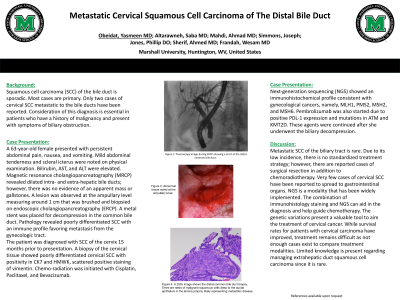Back


Poster Session A - Sunday Afternoon
Category: Biliary/Pancreas
A0051 - Metastatic Cervical Squamous Cell Carcinoma of the Distal Bile Duct
Sunday, October 23, 2022
5:00 PM – 7:00 PM ET
Location: Crown Ballroom

Has Audio

Yasmeen Obeidat, MD
Marshall University Joan C. Edwards School of Medicine
Huntington, WV
Presenting Author(s)
Yasmeen Obeidat, MD, Saba Altarawneh, MD, Ahmad Mahdi, MBBS, Joseph Simmons, MD, Phillip R. Jones, DO, Ahmed Sherif, MD, Wesam Frandah, MD
Marshall University Joan C. Edwards School of Medicine, Huntington, WV
Introduction: Squamous cell carcinoma (SCC) of the bile duct is sporadic. Most cases are primary. Only two cases of cervical SCC metastatic to the bile ducts have been reported. Consideration of this diagnosis is essential in patients who have a history of malignancy and present with symptoms of biliary obstruction.
Case Description/Methods: A 63-year-old female presented with persistent abdominal pain, nausea, and vomiting. Mild abdominal tenderness and scleral icterus were noted on physical examination. Bilirubin, AST, and ALT were elevated. Magnetic resonance cholangiopancreatography (MRCP) revealed dilated intra- and extra-hepatic bile ducts; however, there was no evidence of an apparent mass or gallstones. A lesion was observed at the ampullary level measuring around 1 cm that was brushed and biopsied on endoscopic cholangiopancreatography (ERCP). A metal stent was placed for decompression in the common bile duct. Pathology revealed poorly differentiated SCC with an immune profile favoring metastasis from the gynecologic tract. The patient was diagnosed with SCC of the cervix 15 months prior to presentation. A biopsy of the cervical tissue showed poorly differentiated cervical SCC with positivity in CK7 and HMWK, scattered positive staining of vimentin. Chemo-radiation was initiated with Cisplatin, Paclitaxel, and Bevacizumab. Next-generation sequencing (NGS) showed an immunohistochemical profile consistent with gynecological cancers, namely, MLH1, PMS2, MSH2, and MSH6. Pembrolizumab was also started due to positive PDL-1 expression and mutations in ATM and KMT2D. These agents were continued after she underwent the biliary decompression.
Discussion: Metastatic SCC of the biliary tract is rare. Due to its low incidence, there is no standardized treatment strategy; however, there are reported cases of surgical resection in addition to chemoradiotherapy. Very few cases of cervical SCC have been reported to spread to gastrointestinal organs. NGS is a modality that has been widely implemented. The combination of immunohistology staining and NGS can aid in the diagnosis and help guide chemotherapy. The genetic variations present a valuable tool to aim the treatment of cervical cancer. While survival rates for patients with cervical carcinoma have improved, treatment remains difficult as not enough cases exist to compare treatment modalities. Limited knowledge is present regarding managing extra-hepatic duct squamous cell carcinoma since it is rare.
Disclosures:
Yasmeen Obeidat, MD, Saba Altarawneh, MD, Ahmad Mahdi, MBBS, Joseph Simmons, MD, Phillip R. Jones, DO, Ahmed Sherif, MD, Wesam Frandah, MD. A0051 - Metastatic Cervical Squamous Cell Carcinoma of the Distal Bile Duct, ACG 2022 Annual Scientific Meeting Abstracts. Charlotte, NC: American College of Gastroenterology.
Marshall University Joan C. Edwards School of Medicine, Huntington, WV
Introduction: Squamous cell carcinoma (SCC) of the bile duct is sporadic. Most cases are primary. Only two cases of cervical SCC metastatic to the bile ducts have been reported. Consideration of this diagnosis is essential in patients who have a history of malignancy and present with symptoms of biliary obstruction.
Case Description/Methods: A 63-year-old female presented with persistent abdominal pain, nausea, and vomiting. Mild abdominal tenderness and scleral icterus were noted on physical examination. Bilirubin, AST, and ALT were elevated. Magnetic resonance cholangiopancreatography (MRCP) revealed dilated intra- and extra-hepatic bile ducts; however, there was no evidence of an apparent mass or gallstones. A lesion was observed at the ampullary level measuring around 1 cm that was brushed and biopsied on endoscopic cholangiopancreatography (ERCP). A metal stent was placed for decompression in the common bile duct. Pathology revealed poorly differentiated SCC with an immune profile favoring metastasis from the gynecologic tract. The patient was diagnosed with SCC of the cervix 15 months prior to presentation. A biopsy of the cervical tissue showed poorly differentiated cervical SCC with positivity in CK7 and HMWK, scattered positive staining of vimentin. Chemo-radiation was initiated with Cisplatin, Paclitaxel, and Bevacizumab. Next-generation sequencing (NGS) showed an immunohistochemical profile consistent with gynecological cancers, namely, MLH1, PMS2, MSH2, and MSH6. Pembrolizumab was also started due to positive PDL-1 expression and mutations in ATM and KMT2D. These agents were continued after she underwent the biliary decompression.
Discussion: Metastatic SCC of the biliary tract is rare. Due to its low incidence, there is no standardized treatment strategy; however, there are reported cases of surgical resection in addition to chemoradiotherapy. Very few cases of cervical SCC have been reported to spread to gastrointestinal organs. NGS is a modality that has been widely implemented. The combination of immunohistology staining and NGS can aid in the diagnosis and help guide chemotherapy. The genetic variations present a valuable tool to aim the treatment of cervical cancer. While survival rates for patients with cervical carcinoma have improved, treatment remains difficult as not enough cases exist to compare treatment modalities. Limited knowledge is present regarding managing extra-hepatic duct squamous cell carcinoma since it is rare.
Disclosures:
Yasmeen Obeidat indicated no relevant financial relationships.
Saba Altarawneh indicated no relevant financial relationships.
Ahmad Mahdi indicated no relevant financial relationships.
Joseph Simmons indicated no relevant financial relationships.
Phillip Jones indicated no relevant financial relationships.
Ahmed Sherif indicated no relevant financial relationships.
Wesam Frandah: Endo gastric solution – Consultant. Olympus – Consultant.
Yasmeen Obeidat, MD, Saba Altarawneh, MD, Ahmad Mahdi, MBBS, Joseph Simmons, MD, Phillip R. Jones, DO, Ahmed Sherif, MD, Wesam Frandah, MD. A0051 - Metastatic Cervical Squamous Cell Carcinoma of the Distal Bile Duct, ACG 2022 Annual Scientific Meeting Abstracts. Charlotte, NC: American College of Gastroenterology.

